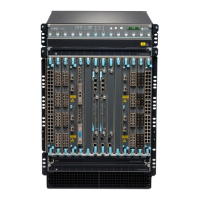• Six 40-Gigabit Ethernet ports, each of which can house QSFP+ transceivers. These ports support
40GBASE-LR4 and 40GBASE-SR4 transceivers. Starng with Junos OS for EX Series switches,
Release 15.1 R3, these ports support the JNP-QSFP-40G-LX4 transceiver.
• 24 10-Gigabit Ethernet ports, each of which can house SFP+ transceivers. These ports support
10GBASE-SR, 10GBASE-LR, 10GBASE-ER, and 10GBASE-ZR transceivers.
• Line card LED—An LED labeled OK/FAIL, which indicates the status of the line card. See
Line Card
LED in an EX9200 Switch
.
• Network port LED—One LED on each network port, the Link/Acvity LED, which indicates the link
status and acvity on the port. See
Network Port LEDs on Line Cards in an EX9200 Switch
.
You can install SFP+ and QSFP+ transceivers in any combinaon in the ports on the line card. The ports
are divided into two port groups. The twelve 10-Gigabit Ethernet ports labeled 0/0 through 0/11 form
PIC 0 and twelve 10-Gigabit Ethernet ports labeled 1/0 through 1/11 form PIC 1; PIC 0 and PIC 1 form
one port group. The three 40-Gigabit Ethernet ports labeled 2/0 through 2/2 form PIC 2 and three 40-
Gigabit Ethernet ports labeled 3/0 through 3/2 form PIC 3; PIC 2 and PIC 3 form the other port group.
The ports in each port group share 240 gigabits of bandwidth. Thus, you can transmit up to 240 gigabits
of trac through a port group, without packet drop.
PIC 0 and PIC 1 are acvated by default. If you deacvate both PIC 0 and PIC 1, PIC 2 and PIC 3 are
automacally acvated. Similarly, if you deacvate both PIC 2 and PIC 3, PIC 0 and PIC 1 are
automacally acvated. You can choose to acvate only one of the PICs and keep the other inacve. To
deacvate an acve PIC, use the power command.
The line card supports the following combinaons of acve PICs:
• Any one PIC
• PIC 0 and PIC 1
• PIC 0 and PIC 3
• PIC 1 and PIC 2
• PIC 2 and PIC 3
NOTE: The line card does not support the following combinaons of acve PICs:
• PIC 0 and PIC 2
• PIC 1 and PIC 3
89

